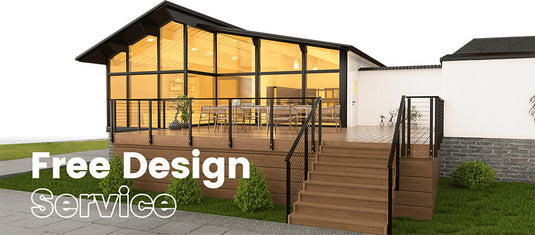Beginner's Guide: How to Install Cable Railings on Your Deck


If you're looking to add a sleek, modern touch to your outdoor deck with the added bonus of not obstructing your view, cable railings might just be the perfect fit for you. But before you dive into installation, it's essential to get a grip on the basics. This beginner's guide will walk you through the entire process, from gathering your tools, to the final touches that will leave your deck not only looking great but also up to safety standards. By following this step-by-step guide, you’ll learn how to install these stylish railings in a way that's straightforward and avoids common pitfalls, giving you all the satisfaction of a well-executed DIY project.
How to Prepare for Your Cable Railing Installation
Before you start drilling and tensioning cables, it's crucial to get your ducks in a row. This section ensures you're fully prepped and ready to go, making the installation process as smooth as possible.
Tools and Materials Needed
Having the right tools at hand is key. Here's what you'll commonly need for a cable railing installation:
- Measuring tape
- Drill with various bits
- Cable cutters
- Wrenches
- Level
- Lag screws or other hardware for attachments
- Stainless steel or galvanized cables
- Cable railing posts
- Cable railing kits (optional, but handy for beginners)
In terms of materials, stainless steel cables are a popular choice due to their durability and resistance to rust, making them ideal for outdoor environments.
Measuring and Planning
Measure twice, install once—that's the motto. Accurately measuring your deck and planning the layout of your railings is critical. Determine where your posts will go and ensure they're spaced consistently—this affects the cable's tension and overall stability. The standard recommendation is to space posts no more than 6 feet apart to prevent the cables from sagging. Also, plan the number of cables you'll need while keeping in mind that most building codes require the space between cables to be less than 4 inches to prevent small children and pets from slipping through.
How to Establish a Strong Foundation with Posts
The success of your cable railing largely depends on the proper installation of posts. These are the backbone of your railing system, so it's essential to get this step right for a strong, durable setup.
Choosing Your Posts
Your choice of posts will affect both the look and stability of your railing. There are typically two materials to choose from: wood or metal. Wood offers a traditional aesthetic and can be less expensive, but it may require more maintenance. Metal posts, often made of stainless steel or aluminum, offer a sleeker look and are resistant to corrosion, making them ideal for outdoor use. Consider what matches your deck's style and your personal preference when selecting.
Setting the Posts
To set your posts:
- Mark Post Locations: Start by marking where each post will go according to your earlier measurements. Ensure they're evenly spaced and exactly perpendicular to the edge of the deck for a symmetrical appearance.
- Prepare Post Holes: For surface mounting, drill pilot holes where your posts will anchor to the deck. For fascia-mounted posts, mark the spots on the side of the deck frame, keeping in mind any overhang or trim boards.
- Secure the Posts: Use appropriate hardware (like lag screws for wooden decks or bolts for concrete surfaces) to secure the posts firmly in place. If you’re working with wood, pre-drilling holes is crucial to prevent splitting.
- Check Alignment: After each post is fastened, use a level to check that it’s perfectly vertical on all sides. This step is critical because even a slightly tilted post can throw off the entire look of your railing and affect the tension of the cables.
- Strengthen Posts if Necessary: In some cases, especially with taller posts or those that stand alone without connecting to a structure, you may need to add additional bracing or supports to ensure stability against the tension of the cables.
Patience and precision here will save you time and trouble later on. Take your time to ensure every post is installed correctly; it's the foundation upon which everything else will rest.

How to Run the Cables
Cable Selection
Your choice in cable will impact not just the appearance but also the strength and longevity of your railing. Here's what to consider:
- Cable Diameter: Commonly, diameters range from 1/8 inch to 3/16 inch. Thicker cables will be more visible and can offer greater strength, while thinner ones tend to be more discreet and emphasize the view.
- Cable Material: Stainless steel is a popular choice for its rust resistance and strength, essential for outdoor applications.
- Cable Make-up: Look for cables described as 'aircraft grade' or 'marine grade,' especially if you live in a coastal area, as these are designed to withstand tough environments.
Cutting and Attaching Cables
With your cables selected, here’s how to cut and attach them:
- Measure and Cut: Measure the length needed for each cable run, ensuring a little extra for adjustments. Use a high-quality cable cutter to make clean cuts without fraying the ends.
- Attach First End: Starting at one end, thread your cable through the pre-drilled holes in your post, and attach using the appropriate hardware like swage fittings or ferrules, depending on your system.
- Run Cable to Opposite Post: Extend the cable across to the opposite post, threading through intermediate posts if present, keeping the cable as taut as possible by hand.
- Secure Second End: At the opposite post, pull the cable tight and secure it into place with the corresponding hardware. The goal is to have the cable snug but not fully tensioned at this point.
As you run the cables, keep in mind the importance of consistent spacing between each line. This not only affects the appearance of your railing but is also important for meeting safety standards that prevent small children and pets from slipping through.
How to Tighten the Lines: Securing and Tensioning the Cables
Now that your cables are cut to length and in place, it's time to secure and tension them correctly. This step is all about precision and patience. Get it right, and you'll have a railing that not only looks fantastic but also meets safety standards and stands the test of time.
Installing the Hardware
Your cable railing system will come with specific hardware designed to hold and tension the cables. This typically includes swage fittings, turnbuckles, or clamps:
- Swage Fittings: These are used to anchor the cable ends after they've been threaded through the post holes. They are crimped onto the cables to hold them in place and often require a special swaging tool.
- Turnbuckles: These devices allow you to adjust the tension of each cable once they're all in place. They typically screw into the end posts or intermediate posts and provide the mechanism for making fine adjustments to achieve the perfect tension.
- Clamps: If your system uses clamps, these will be attached at intervals along the cables to keep them aligned and properly spaced.
Tensioning Basics
The goal when tensioning your cables is to achieve uniform tightness without overloading any part of the structure:
- Start Tensioning: Begin with the middle cable and work your way outwards. Apply initial tension using the turnbuckles or tensioning apparatus, turning evenly on both ends if applicable, until the cable is taut but not overly tight.
- Check Spacing: As you tension each cable, use a spacer or measure the distance between cables to ensure they adhere to building codes and maintain an even aesthetic.
- Final Adjustments: Once all cables are loosely tensioned, go back through and apply final adjustments. The cables should be tight enough that they don't sag noticeably but not so tight that they put undue stress on the posts.
- Equal Tension: Ensure all cables have similar tension. Uneven tension can lead to some cables being too slack and others overstressed, which can cause issues with both safety and longevity.
- Test the Rigidity: Give your railing a gentle shake to feel for any give. All cables should move a little but recover their position quickly without excessive wobbling.
Over-tensioning can warp or damage your posts, while under-tensioning could fail to meet safety requirements. It's a delicate balance, but with careful adjustments, you'll create a sturdy and visually pleasing railing system. Take your time during this phase; it's where your attention to detail really pays off.
Fine-Tuning and Fixes: How to Troubleshoot Your Cable Railings
Even with careful installation, you may encounter a few bumps along the road. This section will help you identify and fix common issues that can arise with DIY cable railing projects, ensuring everything stays secure and looks great.
How to Troubleshoot Issues
Sometimes things don't go as planned, but most cable railing hiccups are easy to diagnose and correct:
- Sagging Cables: If your cables aren't as tight as you'd like, re-tension them starting from the center and working outwards. Remember to adjust both ends of the cable evenly to maintain uniform tension.
- Misaligned Posts: Should your posts not be perfectly aligned, you'll notice the cables might not run parallel. Loosen the hardware attaching the post to the deck, realign it using a level, and then retighten the hardware.
- Uneven Cable Spacing: Inconsistent spacing can occur if the cable has slipped through its clamp or hasn't been tightened properly. Adjust the clamps as needed and ensure each cable is securely held in place.
- Corrosion or Discoloration: Notice any rust or discoloration? Address this early to prevent damage. Clean the affected area and apply appropriate protective coatings as recommended for the material.
How to Fix Common Mistakes
Here's how to address mistakes that can result from a DIY approach:
- Over-tightening: If cables are too tight, they can put unnecessary strain on posts. To fix, simply release some of the tension using the turnbuckles until you achieve the right balance.
- Under-tightening: Conversely, under-tightened cables may lead to sagging. Tighten the cables incrementally, checking tension as you go to avoid overdoing it.
- Incorrect Hardware Installation: It happens—sometimes hardware isn't installed correctly. Consult the manufacturer's instructions to ensure proper setup, and redo any steps if necessary.
- Post Movement Over Time: Check that the footing of each post remains solid. If a post has shifted, you may need to reinforce its base or possibly reset it in its original position.
Regular check-ups and minor adjustments can go a long way in maintaining the structural integrity and appearance of your cable railings. Don't be daunted by the troubleshooting process; even the most seasoned DIY enthusiasts make tweaks along the way. With a little patience and attention to detail, you'll keep your deck railing looking pristine and performing perfectly.
Finishing Up with Your Deck's Cable Railings
And there you have it! Your deck now sports a set of shiny, new cable railings that not only look good but also keep everyone safe without blocking the view. You've measured, drilled, and tightened your way through the project, learning a bit more at each step. It's more than just a job well done — it's about taking pride in a space you've made better with your own hands. Now, it's time to relax on your deck, enjoy the open view, and bask in the satisfaction of a DIY job well executed.

Custom Design Solutions - Fast and Free
Our experts can do all the planning, designing, and budgeting work for you without extra charge.
● Customized Design
● Shopping List
● Budget
